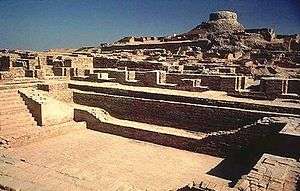Sanitation of the Indus Valley Civilisation

The ancient Indus Valley Civilisation of South Asia, including current day Pakistan and Northwest India, was prominent in hydraulic engineering, and had many water supply and sanitation devices that were the first of their kind.
Among other things, they contain the world's earliest known system of flush toilets. With a number of courtyard houses having both a washing platform and a dedicated toilet / waste disposal hole. The toilet holes would be flushed by emptying a jar of water, drawn from the house's central well, through a clay brick pipe and into a shared brick drain, that would feed into an adjacent soakpit (cesspit). The soakpits would be periodically emptied of their solid matter, possibly to be used as fertiliser. Most houses also had private wells. City walls functioned as a barrier against floods.
The urban areas of the Indus Valley civilization provided public and private baths, sewage was disposed through underground drains built with precisely laid bricks, and a sophisticated water management system with numerous reservoirs was established. In the drainage systems, drains from houses were connected to wider public drains.[1]
Mohenjo-daro
Mohenjo-daro, located in Sindh, Pakistan is one of the best excavated and studied settlements from this civilization. The Great Bath might be the first of its kind in the pre-historic period. This ancient town had more than 700 wells, and most houses in Mohenjo-Daro had at least one private well.[2]
Dholavira
Dholavira, located in Gujarat, India, had a series of water storing tanks and step wells, and its water management system has been called "unique".[3] Dholavira had at least five baths, the size of one is comparable with the Great Bath of Mohenjo-daro.[4]
See also
References
- ↑ Rodda, J. C. and Ubertini, Lucio (2004). The Basis of Civilization - Water Science? pg 161. International Association of Hydrological Sciences (International Association of Hydrological Sciences Press 2004).
- ↑ Singh, Upinder (2008). A history of ancient and early medieval India : from the Stone Age to the 12th century. New Delhi: Pearson Education. pp. 151–155. ISBN 978-81-317-1120-0.
- ↑ Singh, Upinder (2008). A history of ancient and early medieval India : from the Stone Age to the 12th century. New Delhi: Pearson Education. p. 155. ISBN 978-81-317-1120-0.
- ↑ harappa., com. "Ancient Indus Valley Sites". Harappa.com. Harappa.com. Archived from the original on 2013-06-30. Retrieved 4 July 2012.
